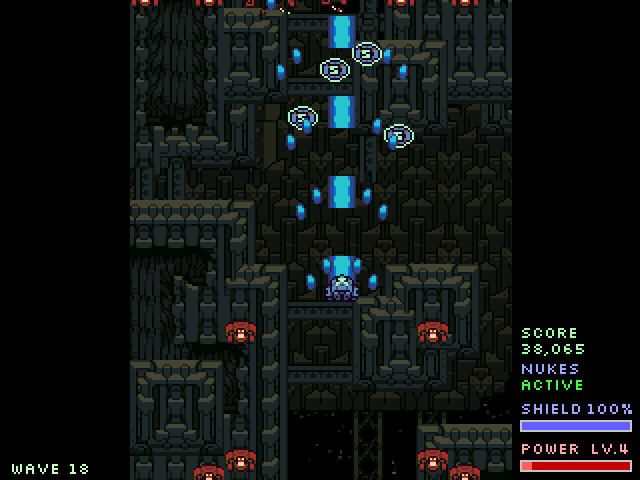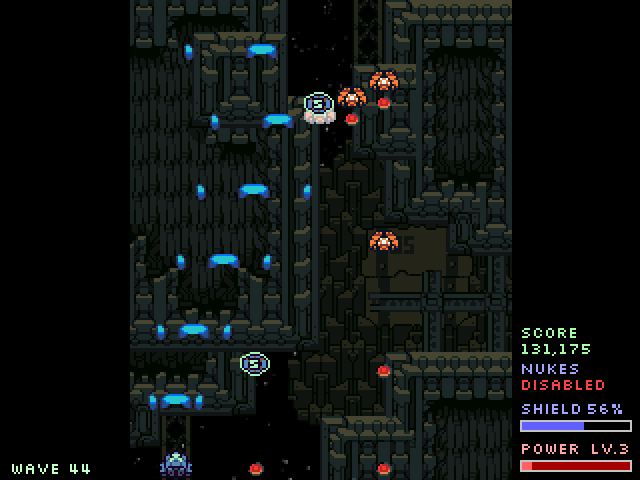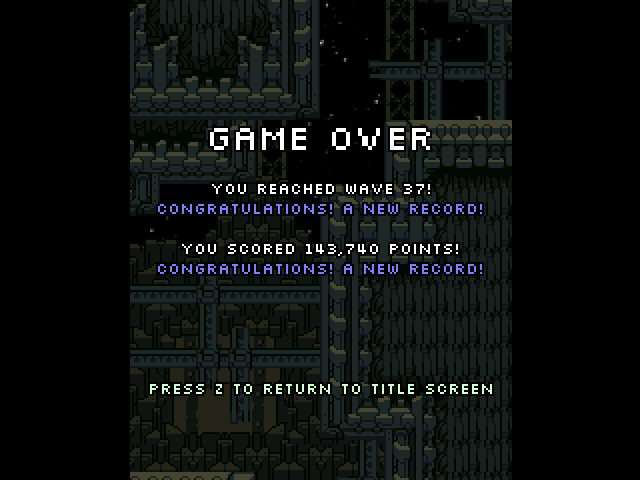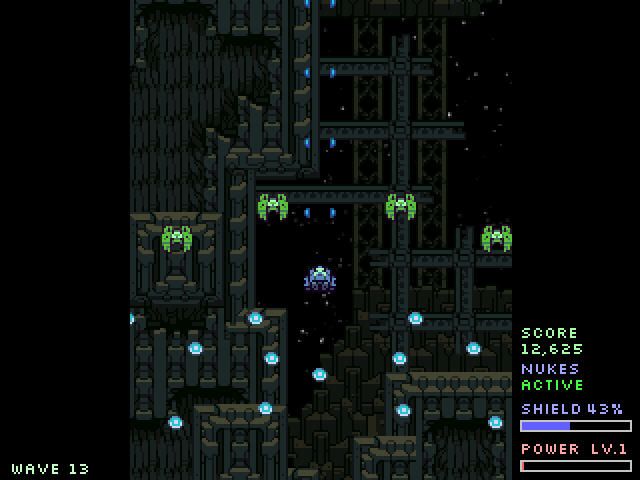Retro Replay Review
Gameplay
Self Destruct delivers a relentless arcade experience built around a deceptively simple premise: pilot a small ship through 250 waves of enemies without letting your defenses collapse. Each wave ramps up the challenge as newly spawned foes exhibit different movement patterns, fire more projectiles, or coordinate attacks in swarm formations. Your ship’s arsenal is equally straightforward—you can shoot a continuous barrage of bullets, deploy a shield that depletes with each hit, or unleash a one-time nuke that obliterates all on-screen threats.
The true hook lies in the procedural generation of enemy waves. No two playthroughs look the same, and the algorithm mixes and matches enemy types to keep you on your toes. You’ll find yourself adapting strategies on the fly: when the screen becomes overrun, timing your shield and nuke uses against denser clusters proves critical. Bonus drops—blue for shield restoration, red for weapon upgrades, yellow for nuke replenishment, and green to max out everything—add an extra layer of risk versus reward as you weave through dangerous patterns to grab them.
Balancing offense and defense is paramount. Upgrading your weapons can turn you into a bullet-spewing juggernaut, but without a shield cushion or nuke in reserve you’ll be overwhelmed by mid- and late-game waves. Mastering each tool’s cooldown and duration forces you to decide: do you save your shield for an incoming projectile storm or use it early to push deeper into a bonus cluster? As waves grow more elaborate, these split-second choices define whether you crack under pressure or build unstoppable momentum.
For players who thrive on high-score chasing, the inclusion of online leaderboards (in the original version) amplifies motivation to learn every enemy pattern and optimize every run. Even offline, setting personal bests becomes addictive: outlasting previous wave records or polishing your bonus collection route keeps the gameplay loop fresh. Self Destruct nails the “just one more try” arcade philosophy, making it easy to lose hours before realizing you’ve reached wave 150 (or higher).
Graphics
Visually, Self Destruct opts for a clean, top-down style that emphasizes clarity over flashy detail. Enemy sprites are color-coded and distinctly shaped so that you can instantly recognize attack patterns—a necessity when you’re dodging bullets from multiple directions. The screen may fill with projectiles and explosions, but the minimalistic design prevents sensory overload, ensuring you always know where your ship is and which pickups are within reach.
Particle effects and explosion animations are brief but satisfying, punctuating each nuke detonation or shield impact with a burst of color and light. Though not ground-breaking by modern standards, the graphic effects are polished and consistent, conveying a sense of impact with every hit. The choice of bright reds, blues, yellows, and greens for bonuses makes them pop against the darker background, guiding your eye to crucial power-ups even in the heat of battle.
Performance is rock-solid, even when hundreds of bullets crisscross the screen. The game runs smoothly on modest hardware, and the responsiveness of your controls never wavers. Frame drops would ruin an arcade shooter of this kind, but Self Destruct maintains a stable framerate throughout intense moments. There’s also a simple heads-up display that shows shield energy, remaining nukes, and wave count without intruding on the action.
While the aesthetic won’t wow players seeking photorealism or richly detailed 3D worlds, its focused approach serves the gameplay perfectly. The streamlined visuals make it easy to concentrate on survival and scoring, reinforcing that this is a throwback arcade challenge rather than a cinematic blockbuster.
Story
In Self Destruct, narrative takes a backseat to pure arcade action, but there’s still a loose sci-fi framework that provides context for the relentless waves of enemies. You’re the lone pilot of an experimental ship designed to withstand extreme onslaughts, tasked with proving its capabilities by enduring ever-intensifying assault fleets. The simplicity of this premise lets players jump straight into the fray without wading through cutscenes or long introductions.
Flavor text between waves and a brief opening mission briefing hint at a larger conflict—unidentified hostiles emerging from deep space, testing human defenses. While the story elements are minimal, they effectively justify the escalating challenge and the availability of powerful weaponry like screen-clearing nukes. There’s just enough lore to imagine a distant war setting, but not so much that it slows gameplay momentum.
For players who crave a narrative-driven experience, Self Destruct may feel light on plot. There are no branching story paths, character development, or dialogue exchanges—just wave after wave of procedurally spawned ships. However, this approach aligns with the game’s design goals: it’s about mastering mechanics and shaving milliseconds off your dodges, rather than unraveling a complex storyline.
The result is a stripped-down, arcade-focused narrative that serves as a vehicle for the core gameplay loop. You get the sense that you’re on a one-man training mission or a gladiatorial test, but the lack of deep backstory keeps the emphasis squarely on high-speed action and score-chasing fun.
Overall Experience
Self Destruct delivers a potent dose of old-school arcade adrenaline with modern convenience. Its procedural wave generation ensures that even veteran players can’t rely on rote memorization—each run demands fresh tactics. The blend of shooting, shielding, and nuking strikes a finely tuned balance between offensive aggression and defensive prudence, leading to tense, heart-pounding sessions that can last from five minutes to well over an hour for top performers.
The straightforward visuals and rock-solid performance mean you never second-guess what’s happening on-screen, letting you concentrate on perfecting your play. While purists of deep storytelling or lush 3D graphics might find it barebones, arcade and bullet-hell fans will appreciate the precision-focused design. Leaderboards add lasting motivation, and the later offline patch ensures you can enjoy every bit of chaos without needing an internet connection.
If you’re looking for a challenging shooter that values skill, reflexes, and decision-making above all else, Self Destruct is a compelling choice. Its combination of procedural wave variety, satisfying power-up progression, and uncompromising difficulty curve make it a standout in the indie arcade shooter space. Just be prepared for a steep learning curve and the occasional frustration when a wave catches you off-guard—but that’s part of the thrill.
In sum, Self Destruct shines as a lean, mean arcade experience. It may not reinvent the shooter genre, but it refines it into a pure, relentless test of endurance and agility. For anyone seeking an engaging time-attempt-based challenge with significant replay value, this game is well worth adding to your collection.
 Retro Replay Retro Replay gaming reviews, news, emulation, geek stuff and more!
Retro Replay Retro Replay gaming reviews, news, emulation, geek stuff and more!









Reviews
There are no reviews yet.